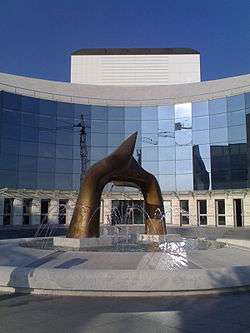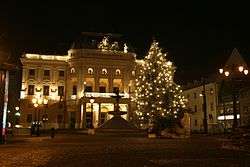Slovak National Theater


The Slovak National Theater (Slovak: Slovenské národné divadlo, abbr. SND) denotes:
- the oldest Slovak professional theater consisting of 3 ensembles (opera, ballet and drama)
- a Neo-Renaissance theater building in the Old Town of Bratislava, Slovakia, which formerly housed two of the theater's ensembles (opera and ballet, drama was based elsewhere), and
- the theater's large modern theater building in Bratislava near the Danube, which opened on 14 April 2007.
Professional theater
The Slovak National Theater is the second oldest Slovak professional theater. It has 3 ensembles (drama, opera and ballet). It was founded in 1920 after the creation of Czechoslovakia as a cooperative and became a state-run company in 1945. Between 1920 and 1945, there was also a musical ensemble. The Slovak National Theater has represented Slovak culture on its numerous tours abroad.
It was created and, in the 1920s, also run by Czech artists (e.g. Oskar Nedbal, director during 1923-1930). The first performance was the Czech opera Hubička by Bedřich Smetana on March 1, 1920. The ensembles were Slovakized only gradually. In 1932, the drama ensemble split into the SNT Slovak Drama Company led by Janko Borodáč, and into the SNT Czech Drama Company, led by V. Šulc. The Czech Drama Company ceased to operate when it was forced to leave Slovakia in 1938. Since then, the drama ensemble has performed in Slovak only, but in the opera ensemble there were Czech artists even after 1945. In recent years, operas have been presented in their original languages.
Initially, all 3 ensembles were active at the old Slovak National Theater building. From 1955 to early 2007, the drama company performed at the P. O. Hviezdoslav Theater and from 1962 to (?)2006 also at a chamber theater called Malá scéna SND (SNT Small Stage). Since 2007, the ensembles perform only at the old Slovak National Theater building and the new Slovak National Theater building opened in April, 2007.
The drama company was shaped by the directors Janko Borodáč, F. Hoffman, J. Jamnický, J.Budský, T. Rakovský, K. I. Zachary, P. Haspra, M. Pietor and the current one – Dušan Jamrich.
The opera ensemble was led by conductors such as Oskar Nedbal, K. Nedbal, J. Vincourek and T. Frešo, and directors including V. Šulc and M. Wasserbauer. The opera became known abroad under the leadership of Czech conductor Oskar Nedbal, who also introduced the first Slovak operas of Jozef Levoslav Bella and V. Figuš Bystrý, and under K. Nedbal, who improved the drama programme. A great boom occurred after World War II. The SNT witnessed the rise of modern Slovak opera by Eugen Suchoň, Ján Cikker, Alexander Moyzes, Tibor Andrašovan, T. Frešo, and many others. Many singers from the SNT are famous abroad, e.g. Edita Grúberová, Lucia Popp, Peter Dvorský, R. Petrák, S. Kopčák, M. Hajóssyová, E. Jenisová, J. Galla, Jozef Kundlák, and many others.
The ballet ensemble has grown from a small group in 1920 to a huge ensemble today.
The old building
This theater's names were earlier: City Theater (Hungarian: Városi Színház-German: Stadt-Theater)

Located by the Hviezdoslav Square, the Neo-Renaissance building was built in 1885–1886 during the time of Austria-Hungary, based on a design by the Viennese architects Fellner & Helmer, who designed theater buildings in 10 European countries. It was opened as the City Theater on September 22, 1886 with the opera Bánk bán of Ferenc Erkel, which is one of the most important Hungarian opera. As a sign of this event's importance Kálmán Tisza Hungarian Prime Minister and his all government, Mór Jókai took part on this ceremony. Gala performance was conducted by Ferenc Erkel himself. The original building was designed for 1000 spectators and was illuminated using 800 gas lamps, while the auditorium had a lustre with 64 lights. The interior was decorated, with frescos of by Pressburg/Pozsony native painter Kornél Spányik and by paintings by Munich artist Leo Lüttgendorf-Leinburg, among others. The City Theater was hired by German and Hungarian professional theater companies, but beginning in 1919 (at the creation of Czechoslovakia), it was used by Czech and later also Slovak ensembles (see above). In 1920 it became the Slovak National Theater.
The new building was constructed on the site of a previous Classic style theater built in 1776, the first permanent theater building in today Slovakia, which was demolished in 1884.
Bratislava native sculptor Viktor Oskar Tilgner crafted the famous Ganymede's Fountain in 1888, now located immediately in front of the theater.
The building has housed Slovak National Theater ensembles since 1920, but today only the opera and ballet ensembles are resident. It was restored between 1969 and 1972, when a new modern technical building was added behind the old building. It features a unique lustre (a special ball) with 2532 bulbs enabling the creation of millions of combinations of light pictures based on a selected programme.
The new building

The design of the new building was begun in the early 1980s, and construction started in 1986. Due to a lack of funds, the building was under construction (with long interruptions) for 21 years, which increased the planned costs from 874 million to almost 5 billion Slovak crowns (although this figure is exaggerated by the relatively high inflation of the 1990s).[1] The building was finally opened on April 14, 2007 and it houses all three ensembles of the Slovak National Theater, although the ensembles continue to use the old building in the Old Town in parallel. The building is designed to hold 1700 spectators at a time in its three sections.
Members
References
- ↑ Otvorili novú budovu SND - Pravda.sk
- ↑ "Adriana Kučerová." (Archive) Pittsburgh Symphony Orchestra. Retrieved on October 4, 2012.
External links
| Wikimedia Commons has media related to Slovenské Národné Divadlo. |
Coordinates: 48°08′33″N 17°06′38″E / 48.1425°N 17.1105°E